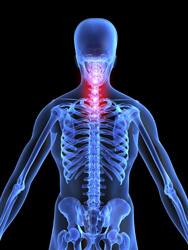
Osteoporosis is the most common bone disease, characterized by diminished bone strength predisposing a person to an increased risk of fractures. This is a major health risk in the United States which results in suffering and a decreased ability to function.
Osteoporosis affects more than 55 percent of Americans. Statistically, one in two women will have a fracture after the age of 50. Eighty percent of the 10 million people with osteoporosis are women. Women can lose up to 20 percent of their bone mass in five to seven years after menopause. If women are educated about the risk factors of osteoporosis, much of this suffering can be avoided. They can adopt lifestyle modifications in order to maximize peak bone mass and alter their eating habits to take in more nutritious sources of protein, such as salmon, other fishes and chicken. Vitamin D and iron can be taken with calcium as supplements which enhance calcium absorption. Exercise in the form of strength training is also an important preventative measure. Although no single type of exercise has been shown to reduce the risk of falls, the most positive results have been observed with balance and strength training, including tai chi and supervised physical therapy programs.
It is also important to identify secondary causes of osteoporosis, such as certain drugs (heparin, phenobarbital and phenytoin) and diseases (rheumatoid arthritis, type 1 diabetes and hypothyroidism). It is equally important to remove obstacles from the house, such as throw rugs. Other fall risks include the use of assistive devices such as canes and walkers; visual deficits; gait and balance abnormalities and arthritis. Eating disorders, extreme exercise, cigarette smoking and excessive alcohol intake may also reduce peak bone mass, thus increasing the probability of declining bone mass later in life.
Unfortunately, osteoporosis is a silent disease with no cure. Dual-energy X-ray absorptiometry (DXA) is considered to be the gold standard for measuring bone mineral density (BMD). After a hip fracture, there is a 20 percent death rate within three months. There can also be long-term disability, with less than 50 percent of previously unaided walkers requiring aids and 50 percent needing help at home.
Hip fractures are the most feared, costly and devastating consequences of osteoporosis. Unless there are successful interventions, annual hip fractures will increase from the current 300,000 per year to 3.9 million in 2025 and 6.2 million by 2050. The cost of fractures will rise from $13.3 billion in 2000 to $240 billion in 2040. Aggressive prevention programs could greatly impact the rate at which fractures increase. Currently, almost half of elderly patients are discharged to a skilled nursing facility after a hip fracture, and about half of those become permanent long-term care residents.
There are numerous medications on the market to treat osteoporosis, such as Raloxifene, Fosamax, Actonel and Boniva. With their patients, physicians can decide the most appropriate medication and plan of care. Prevention of osteoporosis, rather than mere treatment, seems to be the answer. Understanding the risks of osteoporosis may contribute to behavior modification and better decision-making regarding diet, weight-bearing exercise and calcium intake, thus potentially eliminating the need for medication later in life.
There are new studies which advocate DXAs when bone mass is at its peak (age 25 to 30), or at least before the onset of menopause. Establishing a BMD baseline for individual women prior to menopause may be a preventative measure. BMD changes are now determined only after bone loss occurs and are irreversible.
Routine screening beginning after age 65 may be shortsighted in the effort to decrease osteoporosis. Bone density screenings of younger women, age yet to be fully determined, may be one costeffective method to lower the risk. Valuable information regarding preventative measures and treatment options are often poorly disseminated, making the achievement of the best outcomes impossible.
Education for providers should be strongly encouraged. In an effort to maximize peak bone mass, bone health should be discussed with patients beginning in childhood and adolescence and continue throughout the life of the patient. Increased awareness regarding osteoporosis, knowing the risks for this disease, along with fall prevention measures, can decrease the prevalence of this condition and improve the health of women. TPW
